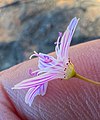
Bougainvillea glabra, the lesser bougainvillea or paperflower, is the most common species of bougainvillea used for bonsai. The epithet 'glabra' comes from Latin and means "bald".
Cardamine pachystigma is a species of Cardamine known by the common name serpentine bittercress. It is endemic to California, where it grows in rocky mountainous areas, often on serpentine and volcanic soils.
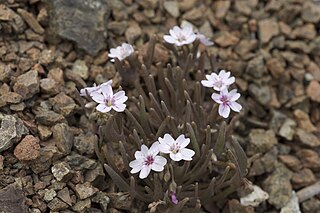
Claytonia gypsophiloides, known by the common names gypsum springbeauty and Coast Range claytonia, is a species of wildflower in the family Montiaceae.

Lewisia brachycalyx is a species of flowering plant in the family Montiaceae, known by the common name short-sepal bitter-root or shortsepal lewisia. It is native to the mountains of the southwestern United States and Baja California, where it grows in moist habitat such as meadows.
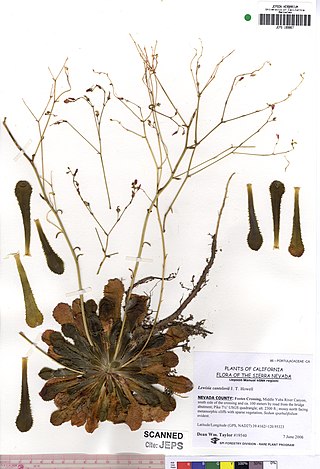
Lewisia cantelovii is an uncommon species of flowering plant in the family Montiaceae known by the common name Cantelow's lewisia. It is endemic to California, where it is known from the northeastern mountain ranges from the Klamath Mountains to the northern Sierra Nevada. It grows in rocky, moist mountain habitat. This is a perennial herb growing from a short, thick taproot and caudex unit. It produces a basal rosette of thick, fleshy, blunt-tipped spoon-shaped leaves with serrated edges. The inflorescence is a very slender erect stem up to 45 centimeters tall topped with a spreading panicle of flowers and glandular, toothed bracts. Each flower has 5 to 7 oval petals each one half to one centimeter long. The petals are white or very pale pink with sharp dark pink veins. At the center of the flower are five stamens tipped with dark pink anthers.

Lewisia congdonii, known by the common name Congdon's lewisia, is a rare species of flowering plant in the family Montiaceae.

Lewisia cotyledon is a species of flowering plant in the family Montiaceae known by the common names Siskiyou lewisia and cliff maids. It is native to southern Oregon and northern California, where it grows in rocky subalpine mountain habitat.

Lewisia disepala is a species of flowering plant in the family Montiaceae known by the common name Yosemite lewisia.

Lewisia kelloggii is a species of flowering plant in the family Montiaceae known by the common name Kellogg's lewisia. It is endemic to the Sierra Nevada of California, where it is known from several sites high in the mountains. It grows in rocky mountain habitat in granite and slate substrates. This is a perennial herb growing from a thick, short taproot and caudex unit. It produces a basal rosette of many thick, leathery, spoon-shaped leaves up to 9 centimeters long. The inflorescence bears several flowers, each on a very short stalk. The flower has 5 to 13 shiny white or pinkish petals just over a centimeter long. Under the petals are two sepals and two similar bracts lined with spherical resin glands.

Lewisia leeana is a species of flowering plant in the family Montiaceae known by the common name quill-leaf lewisia. It is native to California and Oregon, where it grows in the mountains of the Sierra Nevada and Klamath Ranges. This is a perennial herb growing from narrow, woody taproot connected to one or more caudices. It produces a basal rosette of many fleshy flat to cylindrical blunt-tipped leaves up to 4 centimeters long. The inflorescence bears many flowers on erect, branching stems up to about 24 centimeters tall. Each flower has 5 to 8 white, pink, or purplish petals each about half a centimeter long.
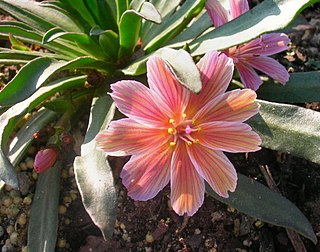
Lewisia longipetala is a rare species of flowering plant in the family Montiaceae known by the common names long-petalled lewisia and Truckee lewisia. It is endemic to the Sierra Nevada of California, where it is known from less than 20 locations in areas not far from Lake Tahoe. It grows in subalpine and alpine climates in moist areas in rocky habitat, such as talus that retains patches of snow year-round. Most specimens grow on north-facing slopes with little surrounding vegetation. The plant thrives in the snow, growing largest and most densely in areas of high snowpack and becoming easily water-stressed when far away from areas with snow.
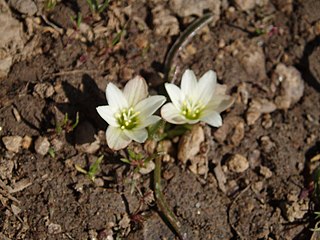
Lewisia nevadensis is a species of flowering plant in the family Montiaceae known by the common name Nevada lewisia. It is native to much of the western United States, where it grows in moist mountain habitat, such as meadows. This is a small perennial herb growing from a taproot and caudex unit. It produces a basal rosette of several narrow, fingerlike to threadlike fleshy leaves up to 13 centimeters long. The inflorescence is a bundle of short stems a few centimeters tall each bearing a flower. The flower has 5 to 10 shiny white to pale pink petals each 1 to 2 centimeters long, pointed or with blunt tips. At the center are many stamens. This is sometimes grown as an ornamental plant suitable for alpine and rock gardens.

Lewisia oppositifolia is a rare species of flowering plant in the family Montiaceae known by the common name opposite-leaf lewisia. It is native to the Klamath Mountains of Josephine County, Oregon, and Del Norte County, California, where it is a local serpentine endemic generally found in moist areas. This is a perennial herb growing from a small taproot and caudex unit. It produces a basal rosette of several lance-shaped, blunt-tipped fleshy leaves up to 11 centimeters long. There are sometimes smaller leaves located on the lower stem. The inflorescence is made up of one or more erect stems up to about 20 centimeters long, each bearing 1 to 6 flowers. The flower has 8 to 11 white to pale pink petals with blunt or jagged tips, each between 1 and 2 centimeters long. At the center are several stamens with pale anthers. This plant has a limited distribution and it is threatened by human activity in the area, such as logging.

Lewisia pygmaea is a species of flowering plant in the family Montiaceae known by the common name alpine lewisia and pygmy bitterroot. It is native to western North America from Alaska and Alberta to California and New Mexico, where it grows in many types of moist, rocky mountain habitat, such as gravel beds and sandy meadows.

Lewisia stebbinsii is a rare species of flowering plant in the family Montiaceae known by the common name Stebbins' lewisia. It is endemic to California, where it is known from less than fifteen sites in the Inner North Coast Ranges of Mendocino and Trinity Counties, mainly in Mendocino National Forest.

Lewisiopsis tweedyi is a flowering plant and sole species in genus Lewisiopsis. The species, formerly known as Cistanthe tweedyi and Lewisia tweedyi, is now classified in the family Montiaceae. The plant is known by the common names Tweedy's pussypaws, Tweedy's lewisia, or Tweedy's bitterroot. It is endemic to western North America in north-central Washington and adjacent British Columbia. It commonly grows on well-drained slopes often on rocky slopes or in rock crevices from low elevation ponderosa pine sites up to the drier part of the Grand Fir zone of the North Cascades. The flowers usually have a coral, apricot, or pink color.
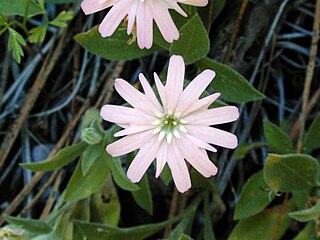
Silene hookeri is a species of flowering plant in the family Caryophyllaceae known by the common names Hooker's silene, Hooker's catchfly, Hooker's Indian pink, and Hooker's glandular campion.
Lewisia maguirei is a rare species of flowering plant in the family Montiaceae known by the common name Maguire's lewisia, or Maguire's bitterroot. It is endemic to Nevada in the United States, where it is known only from eastern Nye County.
Larsenianthus careyanus is a species of the ginger family (Zingiberaceae). It occurs in Bangladesh as well as northeast India. It is the type species of the genus Larsenianthus, which was newly established in 2010.
Larsenianthus assamensis is a species of the genus Larsenianthus in the ginger family (Zingiberaceae). It was first described in 2010 and is native to northeastern India.



